Thomas Picton
| Thomas Picton | |
|---|---|
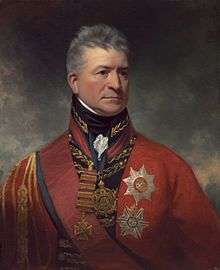 Portrait of Thomas Picton by Thomas Lawrence | |
| Born |
24 August 1758[1] Haverfordwest, Pembrokeshire, Wales |
| Died |
18 June 1815 (aged 56) Waterloo |
| Buried | St George's, Hanover Square, London. (later reburied at St Paul's Cathedral) |
| Allegiance |
|
| Service/branch |
|
| Years of service | 1771–1815 |
| Rank | Lieutenant General |
| Battles/wars | |
| Awards | Knight Grand Cross of the Order of the Bath |
Lieutenant-General Sir Thomas Picton GCB (24 August 1758[1] – 18 June 1815), a Welsh officer of the British Army, fought in a number of campaigns for Britain in the Napoleonic Wars. According to the historian Alessandro Barbero, Picton was "respected for his courage and feared for his irascible temperament". The Duke of Wellington called him "a rough foul-mouthed devil as ever lived", but found him capable.
Picton came to public attention initially for his alleged cruelty during his governorship (1797–1803) of Trinidad, as a result of which he was put on trial in England for illegally torturing a woman. Though he was convicted, the conviction was later overturned.
He is chiefly remembered for his exploits under Wellington in the Iberian Peninsular War of 1807–1814, during which he fought in many engagements, displaying great bravery and persistence. He was killed in 1815 fighting at the Battle of Waterloo, during a crucial bayonet charge in which his division stopped d'Erlon's corps' attack against the allied centre left. He was the most senior officer to die at Waterloo.
Early life
Thomas Picton was the seventh of twelve children of Thomas Picton (1723–1790) of Poyston, Pembrokeshire, Wales, and his wife, Cecil née Powell (1728–1806).[2] He was born in Haverfordwest, Pembrokeshire on (probably) 24 August 1758.[1] In 1771 he obtained an ensign's commission in the 12th Regiment of Foot, but he did not join until two years later. The regiment was then stationed at Gibraltar, where he remained until he was made captain in the 75th in January 1778, at which point he then returned to Britain.
The regiment was disbanded five years later, and Picton quelled a mutiny amongst the men by his prompt personal action and courage, and was promised the rank of major as a reward. He did not receive it, and after living in retirement on his father's estate for nearly twelve years, he went out to the West Indies in 1794 on the strength of a slight acquaintance with Sir John Vaughan, the commander-in-chief, who made him his aide-de-camp and gave him a captaincy in the 17th foot. Shortly afterwards he was promoted major in the 58th foot.[3]
Career in the New World
Under Sir Ralph Abercromby, who succeeded Vaughan in 1795, he was present at the capture of Saint Lucia (after which he was promoted to lieutenant colonel of the 56th Foot) and then that of St Vincent.
After the reduction of Trinidad in 1797, Abercromby made Picton governor of the island. For the next 5 years he held the island with a garrison he considered inadequate against the threats of internal unrest and of reconquest by the Spanish. He ensured order by vigorous action, viewed variously as rough-and-ready justice or as arbitrary brutality. In October 1801 he was gazetted brigadier-general. During the negotiations leading to the Peace of Amiens of 1802, many of the British inhabitants petitioned against the return of the island to Spain; this together with Picton's and Abercromby's representations, ensured the retention of Trinidad as a British possession.
By then, reports of arbitrariness and brutality associated with his governorship had led to a demand at home for his removal. (Picton was also making money from speculation in land and slaves and his mulatto mistress was believed to be corruptly influencing his decisions.) Furthermore, Trinidad no longer faced any external threat, the Pitt ministry had fallen and the new Addington administration did not want Trinidad to develop the plantation economy Picton favoured. In 1802, William Fullarton (1754–1808) was appointed as the Senior Member of a commission to govern the island, Samuel Hood became the second member, and Picton himself the junior.
Fullarton had a very different background from Picton. He came from a wealthy and long-established Scots land-owning family and was a Whig MP, a Fellow of the Royal Society, an improving landlord, and a patron of Robert Burns. He had been a junior diplomat, before raising a regiment in the course of the American War of Independence of which he naturally became the Colonel. He ended that war in India commanding an army of 14,000 men in operations against Tippu Sultan.[4] following which he had written an influential pamphlet arguing that the East India Company had brought trouble on itself by its unprincipled treatment of native princes and native subjects and that a more humane policy than "let them hate so long as they fear" would be more effective in securing its position. The new Secretary of State for the Colonies, Lord Hobart, had served as Governor of Madras soon after the pamphlet came out, knew Fullarton, and had been influenced by his views.
Picton's policy with respect to various sections of the island population had effectively been "let them hate so long as they fear" and he and Fullarton rapidly fell out. (This, of itself, further worsened the rift: Fullarton's Indian pamphlet had also reported adversely on conflicts of interest and dissension between the English having weakened their ability to govern well, to negotiate effectively, and to effectively defend their possessions.) Fullarton commenced a series of open enquiries on allegations against Picton and reported his unfavourable views on Picton's past actions at length to meetings of the commission. Picton thereupon tendered his resignation and was soon followed by Hood (1803).
Arrest and trials
Picton joined Hood in military operations in Saint Lucia and Tobago, before returning to Britain to face charges brought by Fullarton. In December 1803 he was arrested by order of the Privy Council and promptly released on bail set at £40,000 (Picton was able to give surety for half of this; two West Indies plantation-owners covered the remainder).
The Privy Council dealt with the majority of the charges against Picton. Those charges related principally to excessive cruelty in the detection and punishment of practitioners of obeah, severity to slaves, and of execution of suspects out of hand without due process. Only the latter class of charge seems to have seriously worried the Privy Council, and here Picton's argument that either the laws of Trinidad (then still the laws of the former Spanish colonial power: Abercromby had specifically instructed Picton to conduct himself according to those laws[5]) or "the state of the garrison" (martial law) justified the immediate execution in the cases specified eventually carried the day.[6]
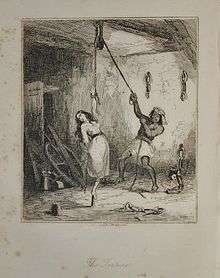
Picton was, however, tried in the Court of King's Bench before Lord Ellenborough in 1806 on a single charge; the misdemeanor of having in 1801 caused torture to be unlawfully inflicted to extract a confession from Luisa Calderón, a young free mulatto girl suspected of assisting one of her lovers to burgle the house of the man with whom she was living, making off with about £500. Torture (but not the specific form) had been requested in writing by a local magistrate and approved in writing by Picton. The torture applied ("picketing") was a version of a British military punishment and consisted in principle of compelling the trussed up suspect to stand on one toe on a flat-headed peg for one hour on many occasions within a span of a few days. In fact Calderón was subjected to one session of 55 minutes, and a second of 25 minutes the following day.[7]
The period between Picton's return and the trial had seen a pamphlet war between the rival camps, and the widespread sale of engravings showing a curious British public what a personable 14-year-old mulatto girl being trussed up and tortured in a state of semi-undress might look like. At the trial, Luisa Calderón gave evidence in person ("Her appearance was extremely interesting, and her countenance, which was that of a mulatto, extremely prepossessing and agreeable"[8]) of the nature and duration of her picketing. The legal arguments, however, revolved on whether Spanish law permitted torture of suspects: on the evidence presented by the prosecution and with Picton's defence being damaged by the cross-examination of his witnesses ("Mr Bourville was examined relative to the nature of the office of alkald, or justice at Trinidad. On his cross examination by William Garrow, he said, the first introduction of torture was by General Picton." ... "Mr Gloucester, the Attorney-General at Trinidad, verified several books as books of authority, in which it was expressly laid down, that by the Spanish law torture might be inflicted; these books were, the Borvillia, the Curia Phillipion, and the Elesando. On his cross-examination he admitted that the Caedula and Raecopilazione were also books of authority. They contained a code expressly applicable to the Spanish West India Islands, and there was not a word about torture in them"[8]) the jury decided that it did not and found Picton guilty.
Picton promptly sought a retrial, which he got in 1808. At this, Picton's counsel stressed that the use of torture had been requested by the local magistrate, that there were copious authorities showing its legality under Spanish law, and that Calderón had been old enough to be legally tortured. Against the argument that torture was legal under the laws of Spain, but nowhere authorised by those of its colonies, he presented a considerable body of depositions from inhabitants of Trinidad showing that torture had frequently been resorted to by magistrates in the last years of Spanish occupation. The jury found that torture was authorised by the law of the island at the time of the cession, and that the defendant acted without malice, further than making an order which he thought himself bound to comply with.[9] They therefore reversed the verdict of the earlier trial but asked for the full court to consider the further argument of the prosecution that torture of a free person was so repugnant to the laws of England that Picton must have known he could not permit it, whatever Spanish law authorised.
Friends of Picton in the military and among slave owners subscribed towards his legal expenses. Picton contributed the same sum to a relief fund after a widespread fire in Port of Spain. He had meanwhile been promoted major-general, and in 1809 he had been governor of Flushing in the Netherlands during the Walcheren expedition.
European military service
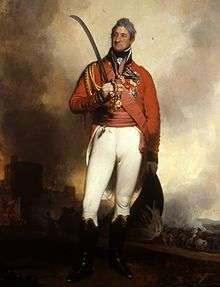
In 1810, at Wellington's request, Picton was appointed to command a division in Spain. Wellington recalled that he had been recommended by General Miranda, who considered him "extremely clever", but also did not trust him, because "he has so much vanity that if you sent him out to the Caraccas or the West India Islands, he would attempt to become the prince of them". Wellington commented when he met Picton,
I found him a rough foul-mouthed devil as ever lived, but he always behaved extremely well; no man could do better in different services I assigned to him, and I saw nothing to confirm what Miranda had said of his ambition.[10]
For the remaining years of the Peninsular War, Picton was one of Wellington's principal subordinates. The commander-in-chief never reposed in him the confidence that he gave to Beresford, Hill and Robert Craufurd but in the resolute, thorough and punctual execution of a well-defined task Picton had no superior in the army. His debut, owing partly to his naturally stern and now embittered temper, and partly to the difficult position in which he was placed, was unfortunate. On the River Coa in July 1810 Craufurd's division became involved in an action, and Picton, his nearest neighbour, refused to support him, as Wellington's direct orders were to avoid an engagement. Shortly after this, however, at Busaco, Picton found and used his first great opportunity for distinction. Here he had a plain duty, that of repulsing the French attack, and he performed that duty with a skill and resolution, which indicated his great powers as a troop-leader.
After the winter in the lines of Torres Vedras, he added to his reputation and to that of his division, the 'Fighting' 3rd, at the Battle of Fuentes de Onoro. In September he was given the local rank of lieutenant-general, and in the same month the division won great glory by its rapid and orderly retirement under severe pressure from the French cavalry at the engagement at El Bodon. In October Picton was appointed to the colonelcy of the 77th Regiment of Foot.
In the first operations of 1812 Picton and Craufurd, side by side for the last time, stormed the two breaches of Ciudad Rodrigo, Craufurd and Picton's second in command, Major-General Henry MacKinnon, both being mortally wounded. At Badajoz, a month later, the successful storming of the fortress was due to his daring self-reliance and penetration in converting the secondary attack on the castle, delivered by the 3rd Division, into a real one. He was himself wounded in this terrible engagement, but would not leave the ramparts, and the day after, having recently inherited a fortune, he gave every survivor of his command a guinea. His wound, and an attack of fever, compelled him to return to Britain to recoup his health, but he reappeared at the front in April 1813. While in Britain he was invested with the collar and badge of a Knight of the Order of the Bath by the Prince Regent George, and in June he was made a lieutenant-general in the army. At this time, Picton purchased the Iscoed estate in Carmarthenshire, Wales.[11]
At the Battle of Vitoria, Picton led his division across a key bridge under heavy fire. According to Picton, the enemy responded by pummeling the 3rd with 40 to 50 cannon and a counter-attack on their right flank (which was still open because they had captured the bridge so quickly) causing the 3rd to lose 1,800 men (over one third of all Allied losses at the battle) as they held their ground.[12] The conduct of the 3rd division under his leadership at Vittoria and in the engagements in the Pyrenees raised his reputation as a resolute and skilful fighting general to a still higher point. Early in 1814 he was offered, but after consulting Wellington declined, the command of the British forces operating on the side of Catalonia. He thus bore his share in the Orthez campaign and in the final victory before Toulouse.
On the break-up of the division the officers presented Picton with a valuable service of plate, and on 24 June 1814 he received for the seventh time the thanks of the House of Commons for his great services. Somewhat to his disappointment he was not included amongst the generals who were raised to the peerage, but early in 1815 he was made a G.C.B.
Death
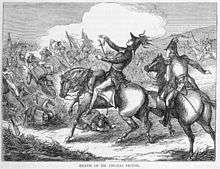
When Napoleon returned from Elba, Picton, at Wellington's request, accepted a high command in the Anglo-Dutch army, and was appointed commander of the 5th Infantry Division. Along with every other senior officer in the army, he was invited to the Duchess of Richmond's Ball that was held on 15 June.
On 18 June, at Waterloo, when Napoleon sent in The Comte d'Erlon's Corps to attack the Anglo-allied centre near La Haye Sainte at 13:30, Picton launched a bayonet charge on the advancing French column. While repulsing the attack with impetuous valour – his last words were "Charge! Charge! Hurrah! Hurrah!"[13] – he was shot through the temple by a musket ball, making him the highest ranking victim of the battle on the Coalition side.
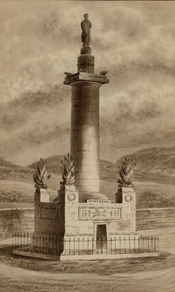

Since his luggage had not arrived in time, he had fought the battle wearing civilian clothes and a top hat. Welsh folklore says that his top hat was shot off by a cannonball moments before his death, but this is not known to be backed by any historical source. Family folklore contends that he did not ride out in tails but in his night shirt and top hat because he had overslept, and that his own men hated him so much that one of them shot him in the back of the head. Again this is not backed by any historical source.
Announcing his death in his typically laconic style, Wellington wrote to the Minister of War, Lord Bathurst:
Your lordship will observe, that such a desperate action could not be fought, and such advantages could not be gained, without great loss; and, I am sorry to add, that ours has been immense. In Lieutenant-general Sir Thomas Picton, his majesty has sustained the loss of an officer who has frequently distinguished himself in his service; and he fell, gloriously leading his division to a charge with bayonets, by which one of the most serious attacks made by the enemy of our position was defeated.[14]
On subsequent examination, Picton's body was found to have suffered a serious musket ball wound to the hip at Quatre Bras on the 16th. Apart from his servant, he had told no one, nor had he consulted a surgeon, choosing instead to bandage the wound himself.[15]
His body arrived in Deal, Kent in Kent on 25 June to a salute from the guns of the ships moored in The Downs. It reached Canterbury the same evening and was deposited in a room at the Fountain Inn where Picton had dined on his way to the Continent. At 6:00 am on 26 June, to the strains of Dead March in Saul, the funeral procession accompanied by the 52nd Regiment of Foot with reversed arms moved off towards London where it arrived on 3 July.[16] He was then interred in the family vault at St George's, Hanover Square. A public monument was erected to his memory in St Paul's Cathedral, by order of Parliament, and in 1823 another was erected at Carmarthen by subscription, the king contributing a hundred guineas. On 8 June 1859, his body was re-interred in St Paul's Cathedral, lying close to the body of the Duke of Wellington.[13]
Namings in his honour
- Places
- The town of Picton in Prince Edward County, Ontario, Canada
- The town of Picton, New Zealand
- Picton, New South Wales, a town named by Picton's military colleague, Lachlan Macquarie
- Picton Junction, Western Australia was named by Waterloo veterans who settled the south west of Western Australia
- Picton Island, at the east entrance of the Beagle Channel in South America; named by Robert Fitzroy and Phillip Parker King[17]
- Roads
- Picton Terrace, Carmarthen, Wales, U.K.
- Picton Road, New South Wales, a highway in Australia
- Picton Road in the Laventille area of Port of Spain, Trinidad
- Picton Street, Montpelier, Bristol. In 1783, while still a captain, Picton endeared himself to Bristolians by facing the rebellious 75th Battalion on College Green, Bristol and averting a military mutiny. There is also a fine double-bayed villa in the street named Picton Lodge
- Public Houses
- The General Picton Inn in Porthcawl.
- The General Picton in Picton Place, Nantyffyllon, Maesteg. The sign bears an image of Sir Thomas. The area also contains a Picton Street named after him; he owned a large amount of land in the area
- The Picton is a public house in Commercial Road, Newport. The sign depicts Sir Thomas in military uniform resting the blade of his sword upon his left shoulder
- Other
- Picton Barracks, Bulford Camp,Wiltshire. The headquarters of the British Army's 3rd Division since 1992
- HMS Sir Thomas Picton. A World War 1, Royal Navy monitor
- The Rhymney Brewery in Rhymney, South Wales, produces a "real ale" (classic cask bitter) named General Picton.
- The Picton, a boys boarding house at Wellington College, Berkshire, an Independent school
- Sir Thomas Picton School (Ysgol Sir Thomas Picton), a mixed comprehensive school in Haverfordwest, Pembrokeshire, Wales.
- Picton Arcade, Swansea. A covered city centre shopping area linking the Kingsway and Oxford Street.
In fiction
In the 1970, Soviet-Italian film, Waterloo, Picton was played by the English actor Jack Hawkins.
Picton's trial is depicted in episode three of the third series of the 2011 television series Garrow's Law; Picton is played by Patrick Baladi.
Likenesses
- Oil portrait (c1812) of Sir Thomas Picton by Sir Martin Archer Shee, in the National Portrait Gallery.[18]
- Oil portrait (c1815) by Sir William Beechey, at Apsley House.[19]
- Bust (1816) by Sebastian Gahagan, in St Paul's Cathedral.[20]
- Lithograph by anonymous artist of Sir Thomas Picton on horseback (1815), in the National Portrait Gallery.[21]
- Serravezza marble statue (1916) of Sir Thomas Picton by sculptor, Thomas Mewburn Crook in Cardiff City Hall.[22][23]
References
- 1 2 3 Authoritative sources such as Havard 2004 give his date of birth as 24 August 1758. Older sources sometimes give it as 20 August, and this is the date that appears on the plaque on his birthplace.
- ↑ Havard 2004.
- ↑ He was probably still acting in a 'staff' role rather than (simply) as a regimental officer : Fortescue History of the British Army notes him 'making his first appearance in these pages' directing reinforcements to various islands without need for reference to Vaughan
- ↑ The general being sacked for incompetence, Fullarton, (a civilian 3 years ago, and fresh to India) was (because he had raised a regiment at his own expense) senior in the Army List to other colonels present, and hence took command (and acquitted himself well)
- ↑ "Law Intelligence – Court of King's Bench – The King v Thomas Picton". Lancaster Gazette. 6 December 1806.
- ↑ This was not a foregone conclusion, nor unimportant to Picton: one of the cases was the execution without trial or court-martial of a British soldier for desertion and rape; in the same period, the former military commander of Gorée was publicly hanged for having a soldier flogged to death without a court-martial.
- ↑ After confessing, she was held for another 18 months before being released: under English law, if found guilty, she would have been eligible to be hanged.
- 1 2 "Trial of Governor Picton". Stamford Mercury. 28 February 1806.
- ↑ "Law Report – Court of King's Bench – TORTURE IN THE ISLAND OF TRINIDAD – The King vs Thomas Picton Esq". Manchester Mercury. 21 June 1808.
- ↑ Philip Henry Stanhope, Notes of Conversations with the Duke of Wellington, 1831–1851, Oxford University Press, 1938, p.69
- ↑ Good Stuff (1982-05-03). "Iscoed - St Ishmael - Carmarthenshire - Wales". British Listed Buildings. Retrieved 2017-01-22.
- ↑ Richard Cannon, Historical Record of the Seventy-fourth Regiment (Highlanders), Published by Parker, Furnivall & Parker, 1847
- 1 2 Dictionary of National Biography
- ↑ "No. 17028". The London Gazette. 22 June 1815. pp. 1214–1215.
- ↑ A Near Observer (1815). The Battle of Waterloo, Containing the Series of Accounts Published by Authority, British and Foreign [&c.].
- ↑ A Near Observer 1815, p. 271.
- ↑ Salvatore Bizzarro, Historical Dictionary of Chile
- ↑ "Person - National Portrait Gallery". Retrieved 17 December 2016.
- ↑ "Beechey - Lt. General Sir Thomas Picton N070463 - APSLEY HOUSE, London. Lt - Photo Prints - 5529827 -". Retrieved 17 December 2016.
- ↑ "St Paul's Cathedral;Monument to Lieutenant General Sir Thomas Picton, Wren, Christopher". Retrieved 17 December 2016.
- ↑ "Sir Thomas Picton - National Portrait Gallery". Retrieved 17 December 2016.
- ↑ statue of Picton by T Mewburn Crook in Cardiff City Hall
- ↑ "Sculpture Gallery - Thomas Mewburn Crook - Sculptor". Retrieved 17 December 2016.
Bibliography
- A Near Observer (1815). The Battle of Waterloo, Containing The Series of Accounts Published by Authority, British and Foreign Sources &c.
- Barbero, Alessandro (2005). The Battle: a new history of Waterloo. New York: Walker & Co. p. 14. ISBN 9780802714534.
- Epstein, James (2007). "Politics of Colonial Sensation: The Trial of Thomas Picton and the Cause of Louisa Calderon". AHR Forum. The American Historical Review. American Historical Association. 112 (3): 712–41. ISSN 1937-5239. JSTOR 40006668. doi:10.1086/ahr.112.3.712 – via JSTOR. (Registration required (help)).
- Havard, Robert (1996). Wellington's Welsh general: a life of Sir Thomas Picton. London: Aurum. ISBN 1854104020.
- Havard, Robert (2004). "Picton, Sir Thomas (1758–1815)". Oxford Dictionary of National Biography (online ed.). Oxford University Press. doi:10.1093/ref:odnb/22219. (subscription required)
- Michelena, Carmen L. (2010). Luces revolucionarias: De la rebelión de Madrid (1795) a la rebelión de La Guaira (1797). Caracas: CELARG.
- Myatt, Frederick (1980). Peninsular General: Sir Thomas Picton, 1758–1815. Newton Abbott: David & Charles. ISBN 0715379232.
- Naipaul, V. S. (1969). The Loss of El Dorado: a history. London: André Deutsch.
- Robinson, Heaton Bowstead (1836). Memoirs of Lieutenant-General Sir T. Picton, including his correspondence, etc. (2nd ed.). London.
- Swann, B.P. (1984). "Sir Thomas Picton: some unpublished facts about his career and relations". Dyfed Family History Journal/Cymdeithas Hanes Teuluoedd Dyfed. 1: 172–5.
External links
| Wikisource has the text of the 1885–1900 Dictionary of National Biography's article about Picton, Thomas. |
| Wikisource has the text of the 1911 Encyclopædia Britannica article Picton, Sir Thomas. |
- www.napoleonguide.com Picton
- BBC: Picton past examined
- narrative – not transcript – of Picton's King's Bench trial
Political Summary
| Political offices | ||
|---|---|---|
| Preceded by Sir Ralph Abercromby |
Governor of Trinidad 1797–1802 |
Succeeded by Commission (William Fullarton, Samuel Hood, Thomas Picton) |
| Preceded by Louis Cesar Gabriel Berthier |
Governor of Tobago 1803 |
Succeeded by William Johnstone |
| Military offices | ||
| Preceded by Sir Charles Hastings, Bt. |
Colonel of the 77th (East Middlesex) Regiment of Foot 1811–1815 |
Succeeded by George Cooke |